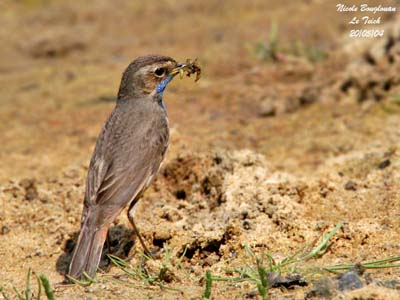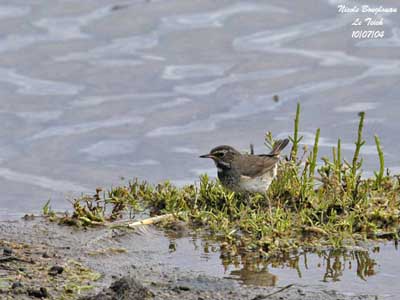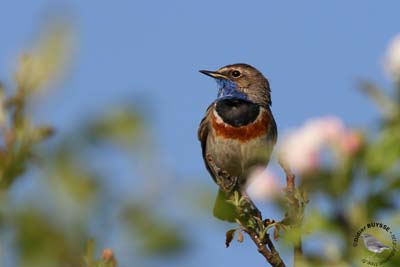
Bluethroat
Luscinia svecica
Passeriforme Order – Muscicapidae Family
BIOMETRICS:
Length: 13-15 cm
Weight: 12-25 g
DESCRIPTION:
Bluethroat is often compared with Common Nightingale (Luscinia megarhynchos) because both are very similar in appearance. However, they differ by the throat colours giving the bird its name.
PROTECTION / THREATS / STATUS:
This species is not threatened at this moment, however, changes and modification of its wet habitats may become an important threat for Bluethroats and some declines are recorded in several regions.
Fr: Gorgebleue à miroir
All : Blaukehlchen
Esp : Pechiazul
Ital : Pettazzurro
Nd: Blauwborstje
Russe: Варакушка
Sd: Blåhake
Port : Pisco-de-peito-azul
Photographers:
Aurélien Audevard
OUESSANT DIGISCOPING
Didier Buysse
Vision d’Oiseaux
Nicole Bouglouan
PHOTOGRAPHIC RAMBLE
Text by Nicole Bouglouan
Sources:
HANDBOOK OF THE BIRDS OF THE WORLD Vol 10 by Josep del Hoyo-Andrew Elliott-David Christie - Lynx Edicions - ISBN: 8487334725
BIRDS OF THE GAMBIA AND SENEGAL by Clive Barlow and Tim Wacher – Helm Field guides – ISBN: 0713675497
L’ENCYCLOPEDIE MONDIALE DES OISEAUX - Dr Christopher M. Perrins - BORDAS - ISBN: 2040185607
LES OISEAUX D’EUROPE ET D’AFRIQUE DU NORD par Hermann Heinzel, Richard Fitter, John Parslow - Delachaux Niestlé - Isbn : 2603014862
THE HANDBOOK OF BIRD IDENTIFICATION FOR EUROPE AND THE WESTERN PALEARCTIC by Mark Beaman, Steve Madge - C.Helm - ISBN: 0713639601
Pájaros de España (JL Beamonte)

Bluethroat adult male summer has brown upperparts. Rounded tail is dark brown with reddish base on outer rectrices. Underparts present a wonderful blue bib with rufous crescent at base of the throat. Below, blue bib is bordered by black, white and rufous bands across the breast. The white band is only a narrow line separating the two other colours. Lower breast and belly are white. Flanks are buffy-white. Undertail coverts have reddish base.
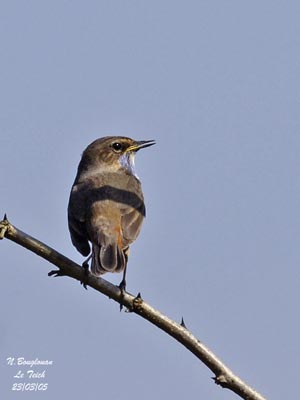
Head is brown, with conspicuous white eyebrow extending from the forehead to the rear of the eye. Eyes are dark brown. Bill is black with yellow lower base. Legs and feet are grey-brown.
In winter plumage, some whitish feathers invade the blue bib.
Female is different, with broad whitish moustache bordered by narrow black malar stripe. She has whitish throat and breast, with a band of black spots across upper breast, as a necklace.
Some adult females may have blue and rufous on lower breast, but most of them lack these colours.
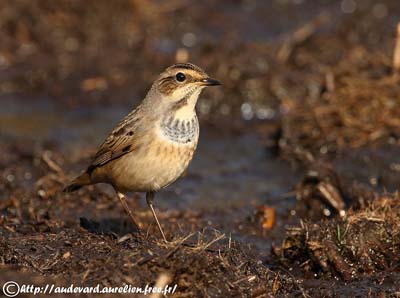
Juvenile has spotted brown plumage, giving a scaly look, but it has the reddish pattern of adults on the tail, just less extended.
First winter resembles adult female with buff tips on wing feathers.
Young male has some blue on the sides of the throat.
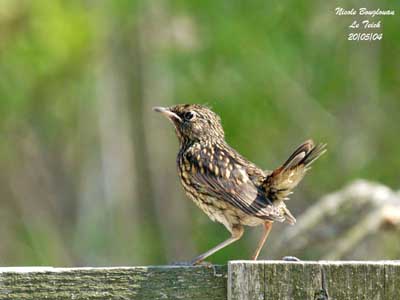
There are ten subspecies, with among them, the main conspicuous patterns, but there are many variations:
Luscinia s. svecica, from northern latitudes with red mirror centre.
(Here described).
Luscinia s. pallidogularis, from eastern Volga, has rufous triangular or bar-shaped patch.
Luscinia s. cyanecula, from Spain, Central Europe and west of Russia, with white mirror. (Here displayed)
Luscinia s. magna, from Caucasus and east Turkey has entire blue throat with very small white patch or not. This is the largest race.
All the subspecies differ in plumage tone and throat and breast pattern.
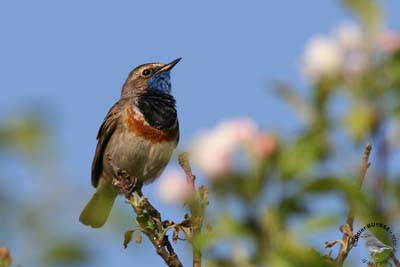
VOICE: SOUNDS BY XENO-CANTO
Bluethroat’s usual call is a hard “tuck-tuck” or “tchak-tchak”, and also a plaintive “hweet”. The loud and varied song includes much mimicry of other species. Rich and sustained, the song includes bell-like notes such as “ting-ting-ting”, and musical notes, hisses and trills.

HABITAT:
Bluethroat breeds on tundra with brushy areas, thickets, wet forest edges, scrubs on hills and mountainous areas, often near water. This species needs low dense vegetation for nesting.
It may be found up to 2600-3800 metres of elevation in Afghanistan and NW Himalayas.
It winters in scrubby waterside and reedbeds.
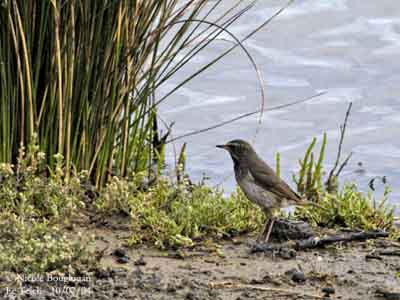
RANGE:
Bluethroat breeds in northern Europe, Eurasia, western Alaska and Yukon Territory.
It winters mainly from north eastern Africa to western India, and in sub-Saharan Africa, from Gambia to Ethiopia, and Saudi Arabia.
Winter areas in North America are unknown, but the species presumed to winter in SE China, crossing the Bering Strait.

BEHAVIOUR:
Bluethroat is an insectivore. It forages in low vegetation to catch insects. When on the ground, it turns over the leaves and the soil to expose small invertebrates. It may hawk flying insects too. It runs on the ground as a mouse. It remains hidden under cover. It has an erect attitude and may stay motionless for a moment.
In winter, we can see it hopping at water’s edge among reeds and bushes.
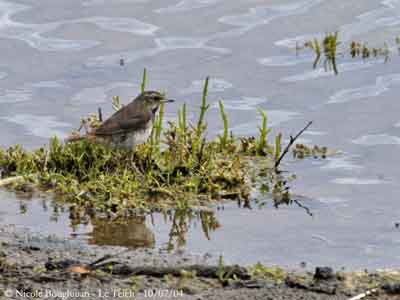
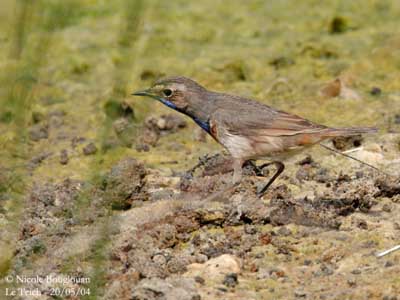
The male sings from an exposed perch, at the tip of a branch of small scrub. The female is shyer and secretive. During the courtship displays, the male often sings while performing flight displays. It also fans its tail to expose the reddish feathers to the female.
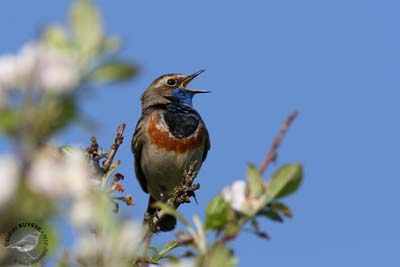
It also guards its mate from other males around the start of the egg laying. It stays within one metre of her, and follows her when she leaves the nest. Copulation occurs under cover of vegetation.
They are territorial, but the boundaries between territories seem to be very flexible.
The species is monogamous, although polygamy has been observed and also extra-pair copulations.

Bluethroat is migratory and moves as soon as possible after the breeding season and moult.
FLIGHT:
Bluethroat flies low, close to the ground, with rapid wing beats, and then, it performs a glide ending into the low bushes. Direct flight is rather swift.
REPRODUCTION:
Breeding season varies according to the range.
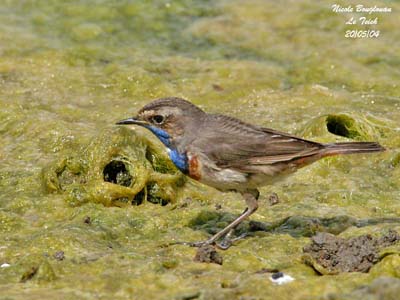
Bluethroat’s nest is located on the ground, concealed in a shallow hole or in tussocks. The nest is a deep cup built by the female with grass, bark, roots and moss. It is lined with softer materials such as animal hair.
Female lays 4 to 7 pale blue or green eggs, speckled with brown. Incubation lasts about 13 to 15 days, by female.
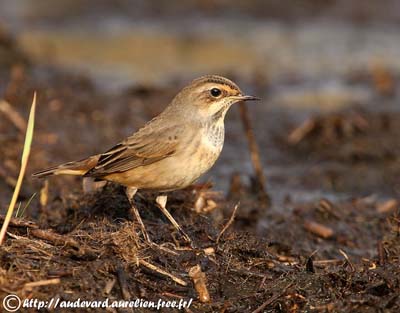
The altricial chicks are covered with sparse slate-grey down. Both parents feed them with insects. Young leave the nest about 13 to 14 days after hatching. If the female starts a second brood, the male takes care of the first chicks alone.
This species may produce two broods per season, but only one in Arctic.
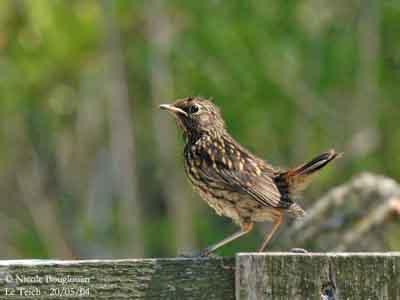
DIET:
Bluethroat feeds mainly on insects such as larvae and adults of different beetle species, hymenopterans, flies, caterpillars, bugs, grasshoppers, crickets and dragonflies. It may consume small snails and earthworms, but also seeds, fruits and berries.
